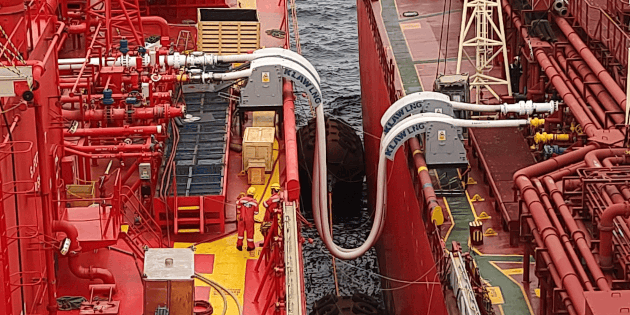World’s First Ship-to-Ship Ammonia Fuel Transfer Marks Major Milestone in Maritime Decarbonization
The world’s first-ever ship-to-ship transfers of ammonia in a test setting were successfully completed by a consortium led by the Global Centre for Maritime Decarbonization (GCMD) in Pilbara, Australia. This groundbreaking trial involved two ammonia carriers: the 35 000-cubic-meter vessel GREEN PIONEER and the 22 500-cubic-meter vessel NAVIGATOR GLOBAL. During the trial, 4 000 cubic meters of ammonia fuel were transferred from GREEN PIONEER to NAVIGATOR GLOBAL. Afterward, the same amount of fuel was transferred back from NAVIGATOR GLOBAL to GREEN PIONEER.
The transfers were specifically designed to replicate real-world ammonia bunkering scenarios in an operational port environment. This meticulous simulation aimed to demonstrate the potential for ammonia as a marine fuel, showcasing how such transfers could take place in ports globally. The entire process was carefully monitored and took about six hours for each transfer. Yara Clean Ammonia, a key partner in the project, provided the ammonia fuel.

Source: GMCD
Due to ammonia’s toxic nature, the trial adhered to stringent safety protocols. These safety measures ensured the well-being of all involved and minimized any environmental risks. GMCD emphasized the importance of these safety precautions, especially as ammonia is known for its hazardous properties if mishandled.
The successful completion of the trial marked a significant step forward in the global push for greener maritime fuels. It further cemented ammonia’s viability as a sustainable alternative to conventional marine fuels like oil or liquefied natural gas (LNG). The GCMD has expressed plans to build on the insights gained from this trial, with the aim of evaluating the feasibility of conducting similar ammonia bunkering operations in other parts of the world. This could pave the way for more widespread adoption of ammonia as a zero-carbon maritime fuel, contributing to decarbonization efforts in the shipping industry.
The trial represents a major milestone in the maritime sector’s transition toward greener technologies, and the successful ship-to-ship ammonia transfers highlight the industry’s ongoing innovation in exploring alternative fuel sources to reduce carbon emissions.

